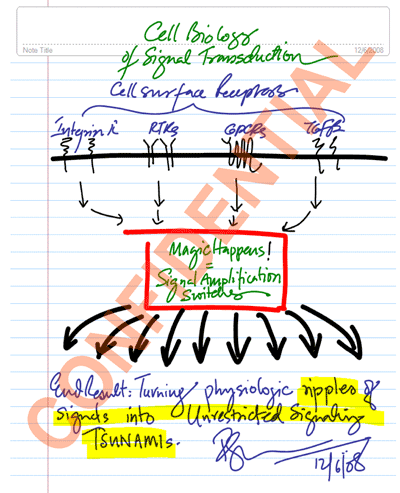About the Ghosh Laboratory
Our Research Focus
The Ghosh lab strives to study the cell biology of signal transduction, with a focus on heterotrimeric G-proteins (trimeric-GTPases). These classes of G proteins have been found on a variety of intracellular membranes since the early 1990's; what they do there remained a mystery. We have systematically pursued in-depth the biological implications of this intracellular trimeric-GTPase system; it is modulated by a novel family of guanine-nucleotide exchange modulators (GEMs) and is fundamentally distinct from the conventional trimeric-GTPase signaling from the cell surface by G protein-coupled receptors (GPCRs).
We were one of the original discoverers of this signaling system beginning with the discovery of GIV-GEM, and subsequently extending to 3 other members (NUCB1/2 and Daple-GEMs). We showed that GEMs serve as vital platforms for intracellular communication networks; they coordinate cellular responses and organellar function in cells responding to environmental signals initiated by diverse classes of receptors, thereby allowing non-GPCRs to engage with and modulate trimeric-GTPases. Using the powerful synergy of cell, molecular and structural biology, molecular imaging, systems biology and bioinformatics, we showed the crucial importance of the GEM system in coordinating diverse cellular processes and revealed the mechanistic basis of their GEM action. As a physician-scientist, my group relentlessly pursued why/how aberrations in the GEM system spur pathogenic conditions such as cancer progression, fibrosis and insulin resistance, and provided the impetus to develop drugs targeting GEMs in these and other disease states.
Although modulation of trimeric-GTPases by GPCRs remains a core target of modern medicine, our discoveries have revealed that trimeric-GTPase signaling via GEMs is just as important, if not more, for coordinating cellular responses in physiology and for diagnosing and alleviating human suffering.
Evolution of a Sketch: 2008–2020
In 2008, this is what we imagined it looks like.....

By 2020, this is what we had unraveled.....

Diverse classes of receptors access and activate trimeric GTPases via GEMs:
- Top: Schematic comparing canonical (left) and non-canonical (right) G protein signaling. Bottom: Regardless of the input signals (canonical, GPCRs; non-canonical G protein-coupled receptors), trimeric GTPases are activated via allosteric conformational changes (marked with arrows) that have similar consequences, i.e., rearrangement of the hydrophobic core of the Gαi-GTPase domain.
- Crystal structure of Gαi with GIV-GEM peptide bound at Switch (Sw)-II. (PDB: 6MHF). Interrupted black box highlights the binding site for GIV, the prototypical GEM.
- Schematic summarizing the various configurations via which GEMs couple diverse receptors to Gαi and trigger downstream signaling (detailed in Box 1 in article). R, receptor; G, trimeric Gαi/s protein; A, adaptor protein, Kindlin.
From: Building unconventional G protein-coupled receptors, one block at a time. Pradipta Ghosh and Madhubanti Mullick; Trends Pharmacol Sci; 2021 Jul;42(7):514-517. doi: 10.1016/j.tips.2021.04.005. Epub 2021 May 10. PMID: 33985816
